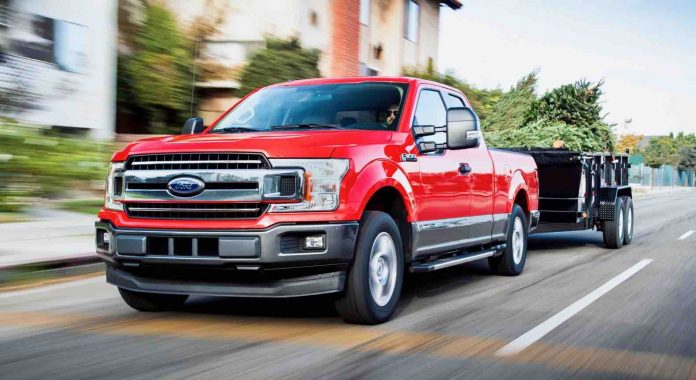
When you get down to it, big power and big capability are the things most esteemed by most of the people who buy a big truck. Does it matter whether that power and capability arise from a big V8 – or a small V6 that makes bigger horsepower and delivers more capability?
Ford’s bet is that buyers want the horsepower and torque – and if a six makes more of both while also using a bit less gas – then the V8 isn’t going to be missed much.
Italics for a reason.
It’s the same reason for the 2018 Ford F-150’s all-aluminum body and its new ten-speed automatic transmission.
To squeeze out the MPGs – what the government demands – without putting the squeeze on the horsepower, torque – and capabilities – most truck buyers want.
So far, so good.
WHAT IT IS
The F-150 is Ford’s full-size pickup truck.
You can get it in various combinations of cab/bed, like most of its half-ton rivals – including the Chevy Silverado, Ram 1500, Toyota Tundra and Nissan Titan. But the Ford is uniquely skinned in lightweight aluminum and is the only one of the bunch whose flagship engine isn’t a V8 engine.
Base price is $27,705 for an XL trim regular cab with 2WD, 6.6 foot bed and 3.3 liter V6 (new for 2018).
Ford offers two V6 upgrades – both with twin turbos and also (for the traditionalist) a 5.0 liter V8. Most of these engines can be ordered with any trim/cab/bed iteration of the F-150, except for the top-of-the-line, 450 hp version of the top-dog 3.5 liter “EcoBoost” V6, which isn’t available with the base XL trim.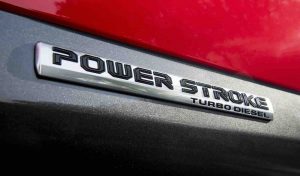
There is also a new 3.0 liter Powerstroke turbodiesel V6 engine option – which will be available later this summer. It looks like Ford will offer this engine with the base XL trim, but not the regular cab XL. You’ll need to step up to at least the extended cab (SuperCab) XL, which stickers for $31,790 to start with 2WD and the standard 6.6 foot bed. The diesel option adds $4,000 to the truck’s base price.
A top-of-the-line crew cab (SuperCrew) F-150 Limited with the high-performance 3.5 liter twin-turbo V6 and 4WD tops the range, stickering for $64,275.
The really big news – channeling Ed Sullivan – is the addition of that hunky turbodiesel engine to the F-150’s roster of available powertrains. It is Ford’s reply to the challenge presented by the Ram 1500 – which already offers a diesel engine – and Chevy, which will offer one in the Silverado come 2019.
Also, all the other engines get upgraded.
The standard engine is a smaller – but stronger – 3.3 liter V6; the mid-range 2.7 liter twin-turbo V6 produces 25 ft.-lbs. more torque than last year and the 5.0 V8 produces 10 more horsepower and 13 ft.-lbs. more torque than before. The top-of-the-line 3.5 liter twin turbo V6 now peaks at 450 hp and 510 ft.-lbs. of torque. A lower-powered 375 hp and 450 ft.-lbs of torque version is still available, too. 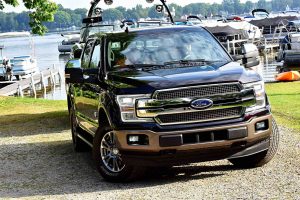
A ten-speed automatic is standard with all engines except the 3.3 gas V6 and the 3.0 liter turbodiesel V6. They are paired with six-speed automatics.
All 2018 F-150s get small but significant exterior styling tweaks as well.
WHAT’S GOOD
Widest range of engines in the class – including 30 MPG-capable diesel.
Highest tow rating (13,200 lbs.) in class.
Almost limitless cab/bed/drivetrain combinations.
Lightweight (and corrosion-resistant) aluminum skin.
WHAT’S NOT SO GOOD
Aluminum skin is light and more corrosion resistant than steel – but more difficult (and expensive) to repair than steel if it’s damaged. And it’s more easily damaged than steel.
Twin turbo engines are more complex engines than V8 engines. You save some gas money, but might spend more money on maintenance and repairs down the road. The truth is we won’t know for awhile – until these engines have been in service for at least 8-10 years out in the real world.
Like all current 1500s, the F-150 is really tall-walled. Even for a tall man, reaching into the bed is a stretch. And getting into the bed may involve a step ladder (which Ford offers).
No less than five engine choices are offered – two more than GM and FiatChrysler (Ram) offer, three more than Toyota offers and four more than Nissan offers.
A 3.3 liter V6 replaces last year’s slightly larger 3.5 liter V6 as the F-150’s standard engine. It makes 290 hp and 265 ft.-lbs, of torque – an uptick from the 3.5 V6’s 282 hp and 253 ft.-lbs. of torque.
It’s paired with a six-speed automatic and you can go 2WD or 4WD.
The next-up engine is a 2.7 liter V6 with a pair of turbos boosting its output to 325 hp and 400 ft.-lbs. of torque. Almost as much horsepower as the Silverado’s 5.3 liter V8 (355 hp) and more torque than the nearly twice-as-large V8 put out (383 ft.-lbs.)
A ten speed automatic is standard with this engine.
If you want a V8, it’s still on the menu. 5.0 liters and 395 horsepower/400 ft.-lbs. of torque. It almost exactly matches the output of the Ram’s top-of-the-line 5.7 liter V8 (395 hp and 410 ft.-lbs. of torque) and the Titan’s standard (and only) 5.6 liter V8 (390 hp and 394 ft.-lbs. of torque). The Ford V8 also outguns both the Toyota Tundra’s standard 4.6 liter V8 (310 hp, 327 ft.-lbs. of torque) and its top-of-the-line 5.7 liter V8 (381 hp, 401 ft.-lbs. of torque).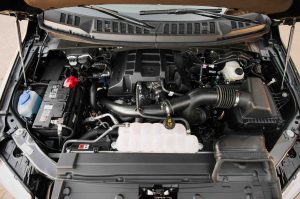
But the apex of F-150 power is the twin-turbo (20 psi of boost at full tilt) 3.5 liter V6, now making 450 hp and 510 ft.-lbs. of torque. Not only is this more hp and torque than last year’s version of the 3.5 liter “Ecoboost” V6, it’s slightly more power (well, torque) than the same engine found under the hood of the Lincoln Navigator. You now get the same hp (all 450 of them) and an extra 10 ft.-lbs. of torque (510 vs. a scanty 500) in your Ford.
You can almost hear Austin Powers saying Oh, behave!
This engine is a titan – pun intended. It makes more horsepower than all the competition’s much larger V8s – including the next-best 6.2 liter V8 that’s optional in the Silverado. All you get there is 420 hp and a puny 460 ft.-lbs. of torque.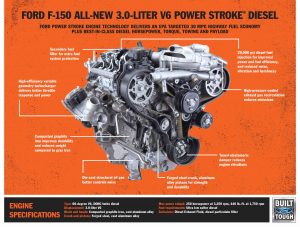
I averaged 19.2 MPG after a week in a SuperCrew F-150 with this engine. EPA rates it at 16 city, 21 highway.
The wild card engine, though, is the new 3.0 liter turbodiesel V6. It makes a relativey modest-sounding 250 hp – but also 440 ft.-lbs. of torque – more than the 5.0 liter V8 and not all that far from the twin-turbo V6.
But (unlike them) it’s capable of 30-plus MPG on the highway.
The Ram is the only other truck in this class that – for now – also offers a diesel engine. It’s also 3.0 liters but makes a bit less hp (240 hp) and significantly less torque (420 ft.-lbs.). GM has a diesel on deck, but it’s not available yet. (Nissan offers a turbodiesel V8 in the Titan XD- which is a step up from the standard 1500-series Titan but not quite as butch as a 2500 series truck. It’s a unique offering, not directly comparable. )
ON THE ROAD
Trucks are what big sedans once were – roomy, full-framed, comfortable and powerful. Also capable. You can pull a house off its foundations – just about. And you’ll not be stopped by weather.
The only downside – and this is subjective – being their height and their width. The F-150, like its brethren, takes up pretty much every inch of lane. Interestingly, the truck itself is about the same width (79.9 inches) as a ’70s-era F-truck (79.4 inches wide). But the track of the new truck is much wider – 73.9 inches up front, 73.6 inches in the rear – vs. 64.2 inches up front and 64.4 inches in the rear for a circa 1976 F-150. That wider stance definitely improves the ride – the new truck floats more serenely than a ’76 Cadillac Sedan de Deville and forget the ’76 F-truck, which rode like a tractor. But it also imparts that Ben Swolo wide-stance feel.
These trucks are arguably getting too wide for some of the roads out there.
Also parking spots.
These have been downsized to accommodate today’s less Ben Swolo-ish cars; you will discover that getting the F-truck’s doors fully open when parked in these narrow spots is often not doable.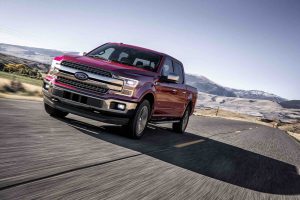
All the engines except the standard 3.3 V6 are tremendously powerful. The standard 3.3 V6 is merely sufficiently powerful. The 450 hp twin-turbo V6 is so powerful that you can out-accelerate most sports cars a third the size of this thing: Zero to 60 in 5.8 seconds.
And that’s a fun thing!
Also that you can do a burnout. There is traction control, but it can be turned off. Some of the others will cut throttle if you hold the brake at the same time you’re easing into the gas – in order to light up the rears, which is also a fun thing!
On a more Responsible Adult Note: The engineers have done good – no, excellent – work with the shifting action of the new ten-speed automatic, which Ford developed jointly with GM (the new Cadillac Escalade – reviewed here – uses the same transmission). With all those gears, you’d expect confused shifting. But the programming is righteous because the gear changes are perfectly timed – even when the box jumps up (or down) three gears. Which it does without any stumbling or bogging. It’s hard to tell when it shifts, unless you’re watching the display.
Tenth – which is a deep overdrive (after the prior two overdrives, 9th and 8th) generally won’t engage until you’re doing at least 60, but when it does, the revs at 60-ish fall to just over 1,200 RPM – and that is just the ticket for squeezing out an extra MPG – maybe even three – vs. a six-speed box.
Lots of minor detail touches for 2018, including rolled a new billet-style grille and a hood lip that’s chamfered (rolled) forward to flow toward the grille. Out back, “F-150” is stamped into the tailgate.
In the bed, there’s soft-glow LED lighting and a spray-in bedliner, much to be preferred over the bolt-on plastic ones, which trap moisture in between and so accelerate rusting.
Speaking of which…
That’s less of an issue with the F-150 because the bodywork is all aluminum – and while aluminum does corrode, it doesn’t rust like steel does. The use of aluminum also shaves several hundred pounds of deadweight off the truck, while is why the F-truck is the lightest current half-ton and also gets the best fuel mileage (although the difference isn’t huge).
But back to the bed for a moment.
It is a very tall bed. So tall that even a very tall man – me, I am 6ft 3 – can only just barely touch the bed floor while standing outside the truck. That makes getting things out of the truck a challenge. Getting in the bed, too. It’s why Ford offers what I call The Metamucil Pole – and a built-in step ladder that comes along with it – but it’s not just for the old and crickety.
The older trucks – those built before the early 2000s, when Cod Piece Fever began to take hold – had beds you could access and get in and out of without a step ladder or Metamucil Pole to hang onto. They carried as much cargo – but it was much easier to load and unload because the gunwales of those trucks were not so blankety-blank high.
It’s not just Ford that’s guilty of this functional atrocity, either. All current 1500s are so afflicted. Apparently, because function matters less than form.
Gotta look butch.
THE REST
It’s Ford making some very tangy lemonade, if you get my meaning. The government issues fuel economy fatwas because the buying public – damn them – continues to put fuel economy a distant third or fourth to other considerations – such as power and capability. Left in peace, the buying public would buy big V8s. But the government doesn’t want them to buy them – so the government keeps on ratcheting up the fuel economy fatwas, which have the effect of gradually regulating V8s out of existence – the buying public be damned.
The “EcoBoost” V6 doesn’t get spectacularly better mileage than a V8 (16 city, 21 highway vs. 15 city, 20 highway for Chevy’s 6.2 V8) but that slight uptick lets Ford tout how “fuel efficient” the F-truck is; shows how eager Ford is to “improve fuel economy” … vs. GM and Ram and the rest with their dastardly V8s.
It gets Uncle off their backs a little – and it helps a lot (believe it or not) with the federal fatwas, which impose fines based on averages. The EcoBoosted V6’s slight MPG advantage is of small relevance to the individual owner – but factored over all the F-trucks Ford sells each year, it is of major relevance to Ford – which pays lower “gas guzzler” fines, and so doesn’t have to pass those on to us, the buyers.
Meanwhile, the “EcoBoost” V6 is the strongest engine you can get in a 1500 truck.
Bits and pieces: The Ford offers a household-style 110V (400 watt) three-pronged power point – two of them, actually. One up front and the other in back. So you can keep multiple laptops powered up – or even run power tools.
You can also get Pro Trailer back-up-assist – which effectively automates maneuvering with a trailer attached.
Just be aware that if you remove the tailgate, you will also “remove” the back-up camera, which is built into the tailgate.
THE BOTTOM LINE
The new F-150 proves that displacement can be replaced.
Steel, too!
. . .
Got a question about cars – or anything else? Click on the “ask Eric” link and send ’em in!
If you like what you’ve found here, please consider supporting EPautos.
We depend on you to keep the wheels turning!
Our donate button is here.
If you prefer not to use PayPal, our mailing address is:
EPautos
721 Hummingbird Lane SE
Copper Hill, VA 24079
PS: EPautos magnets are free to those who send in $20 or more. My latest eBook is also available for your favorite price – free! Click here. If you find it useful, consider contributing a couple of bucks! 



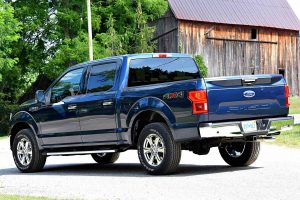


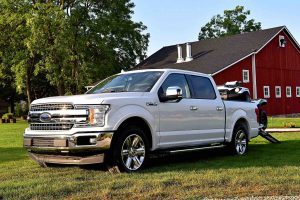









The Ecodiesel has been updated for 2019, and is reported to have increased horsepower and torque (260 and 442 respectively).
I miss the Ford Ranger. At one time there was talk about bring back the F100.
There’s still no replacement for displacement. A Magnusen supercharger on a 5.7 litre V8 will stomp the piss out of any twin turbo V-6 they can roll out.
I never thought I’d see the day, but I’m actually getting to the point where I don’t like trucks anymore.
I used to like trucks because they were simple, cheap, handy, and easy to maintain. Today they’re expensive, complicated, and HUGE. And who in their right mind wants to start throwing chunks of jackhammered concrete or an engine block into the aluminum bed of a $60,000 truck?
Maybe some of these new small-displacement engines that put out monster torque are good, but I still don’t trust them. In my experience the longest-lasting and most reliable engines were always the low-RPM engines like the Ford 4.9 six that throbbed along at a leisurely 1900-2000 RPM.
I have a 2008 F-150 with the last year of the Essex long-stroke 4.2 V6 and the last year of the manual transmission. It doesn’t have a single option on it. It gets 19.5 MPG. I’d give my left nut to be able to buy a brand-new truck like that again.
Seems to me that the new super-efficient engines aren’t improving gas mileage all THAT much… they’re just enabling the auto companies to build monster trucks and charge sixty grand for them instead of building basic trucks with basic engines for $17-18,000 that can get 19-20 mpg all day long.
A former coworker has the 2017 aluminum F-150 with the large EcoBoost engine, and it was solid. He had a couple of side-jobs, one as a baseball umpire that took him all over the Texas/Oklahoma area to officiate, so he would put a lot of highway miles on (40k a year). But he was also a custom home builder, and he would use it to tow trailers with building supplies and equipment on them. I think his max tow was 15,000 lbs, and the engine had no problems with it.
The only warranty work he has done was for a noisy rear differential. Otherwise it has been very reliable for him.
I don’t know what service intervals he’s been following, but I expect it’s just whatever Ford recommended. If it were my truck, with twin turbos, I’d be changing the oil on the “severe service” interval just so the bearings in them got lots of fresh oil.
Noticed in the pic of the AC power plug: Are they heated rear seats?
Check the new GMs out ( good old Al 13 is starting to show up there) Even plastic beds, actually nothing wrong with that. More mass may equal more ass, after a while the extra pounds are a burden.
You have to admit, steel was the perfect material for the auto industry for years, had its built in obsolescence, held dents well, most guys with bondo could patch the holes or modify with a torch and pounds of lead.
Ol’ Fe was King , long live the King!
Eric, the Ecoboosts have been out 8 years already! There are many stories of 200k+ ones out there w/no problems & some are approaching 400k miles!
Hi Mike,
This is true; of course, I’m cautious… I’d like to know how they hold up over 15-plus!
When a vehicle is damaged in a collision, the decision to repair or total the vehicle is based on the cost to repair versus the value of the vehicle. With these aluminum bodies being more expensive to repair, these vehicles will being totaled by the insurance companies and taken off the road earlier than a steel equivalent.
My question is … do you have to lift off the cab just to do minor engine repairs ???
Witty comment.
Looks pretty cramped in there. Home repairs are harder and harder to do these days.
Not so witty – even the shops pull the cab to replace spark plugs on at least some Ford peecups.
One thing I wasn’t crazy about in the old ones was the smaller leg room compared to the 2nd Gen Silverado’s which I now own one of. Seems like they made some more space in that effort. Under the hood seems like cost of ownership and risk of failure is going up. Unless I am wrong, my gut assumption is the turbo will shorten the lifespan of these smaller engines by putting more stress on them. Unless these were engineered specifically for a turbo?
One thing I never understood with the F150 fanfair was their rush to downsize and aluminize, yet their owners bought the new F150’s with just as much vigor. I don’t speak for all truck drivers but if I am in a 4 ton vehicle I would like it to sound like it has some pep in it and not a sewing machine and be ultra quiet. I’m not running cammed or no muffler but a truck shouldn’t suck air like an import v4/v6. That is just personal preference and probably why the current truck is the last vehicle I will own till they are outlawed. A friend of mine dropped $50k for a 2016 with the extended range fuel tank (he claims 600 miles per tank, somewhat jealous of that) and thoroughly enjoys the coyote engine inside. My dad had a 9th Gen F150 that had the dual gas tanks that held 40 some gallons i think.
re this: “It’s not just Ford that’s guilty of this functional atrocity, either. All current 1500s are so afflicted. Apparently, because function matters less than form.”
I thought the tall truck beds were to help meet the All Cars Can Be Turned Upside Down And Not Crush The Roof federal fatwa — if the truck is upside down and the points in contact with the ground are the top tail of the truck bed and the rear edge of the roofline.
Hi Jim,
That could be… but it’s also because of the trend to emulate the “tough” look of the old Super Duty models… it’s crazy. As I wrote in the article, I’m taller than probably 95 percent of men and I can just barely finger-tip touch the bed floor when standing next to it. The GM and Ram trucks are just as bad in this respect.
My theory is that because of the side impact standards, the window-line in the doors has to be much higher. And for styling reasons, that line gets carried to the back of the vehicle.
The bed sides of my ’71 Custom 10 Deluxe come up to the bottom of my rib cage, the perfect height. It’s also easier to get in and out of the cab without the need for running boards or grab handles because of the lower ride height.
Thats why there is a market for flatbeds I suppose( A lot of Farmers have them)